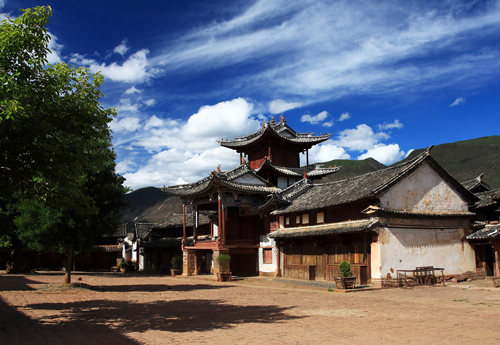|
 |
|
ANCIENT THEATER: Sideng Theater in Shaxi Town, Jianchuan County in southwest China's Yunnan Province, has a history of more than 1,000 years and still retains its originality (CFP) |
The team that restored the city's old town trialed new and original techniques in order to preserve the area's distinct identity. Feiner, who made his name on groundbreaking restoration work in Yemen's Sanaa, insisted on restoration rather than rebuilding, and the use of traditional techniques and materials. "When modern additions are made, they should be clearly visible as such, rather than being made to blend in by using modern methods and a faux-traditional style," he said.
Huang Yinwu, an architect from the same team, echoed this idea. "To keep its originality doesn't mean we disguise the new as something old. It's about keeping the spirit of buildings and sites intact."
From 2003 to 2004, Huang and his team spent a whole year piloting their ideas on two buildings in Shaxi. During the process, they learnt more about the structures and materials used in the old buildings. They selected some craftsmen from the town and employed traditional skills in restoring their original appearances.
After that, Huang's team started to work on the town's most prominent structures—the theater and the gate of Xingjiao Temple.
"Usually in a restoration project, the construction team submits a plan before they begin work," Huang said. "But in this case that wasn't viable as we encountered many new problems during restoration such as leaking roofs and issues of drainage. So we had to constantly adapt our plans."
This painstaking method proved time-consuming and costly. Seeing neighboring regions including Lijiang benefit by demolishing old buildings and rebuilding in a traditional style, the local government became keen to copy the model.
"Lijiang is not a good example for us," Huang said. "Naxi culture is sold to tourists in Lijiang like in a big shopping mall. Development there isn't sustainable. If the tourism boom declines, there will be nothing left of the culture."
In Shaxi, he explained, tourism isn't yet established, and it remains uncertain how it is going to develop. There is no hotel in town, only a few family guesthouses. "We should aim for slow but sustainable development. For the project to succeed long-term, the entire Shaxi Valley, and its historical villages, need a plan for sustainable development, which allow local Bai farmers a way out of poverty without losing their culture," he said.
The local government eventually acknowledged that plans based on mass tourism were not suitable for Shaxi. Feiner and Huang's restoration work continued. Today the market has been drained and relaid, the temple cleaned up and reopened for worship, and the stage is ready once again for local performances. More and more travelers have also begun making their way to the town.
Shaxi Quick Facts
Covering 287 square km, Shaxi Town is home to about 50,000 residents and has a history of more than 1,000 years. People of the Bai ethnic group account for 90 percent of the local population.
The Bai people are mainly agricultural. Their main staple crops are rice and wheat. Their houses are two-storeyed, with the family living on top and livestock below. The style is distinctive, with mud bricks, graceful eaves and tiled roofs. The main Bai religion is worship of local tutelary spirits. Linked with the religious Guanyin Festival, the traditional ceremonies are still alive. Nowadays, the festival is most important for markets, performances, competitions and games.
Email us at: yuanyuan@bjreview.com | 